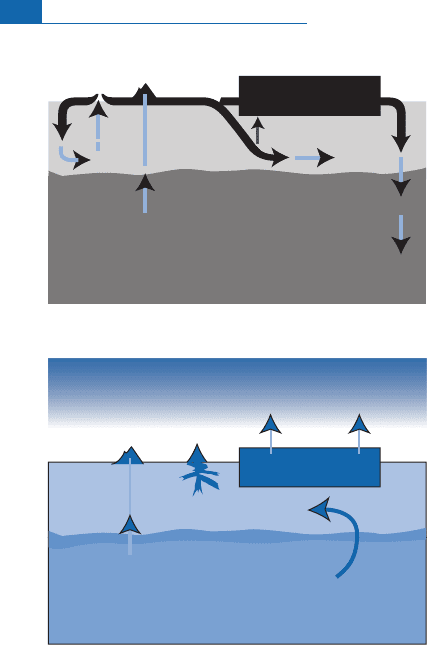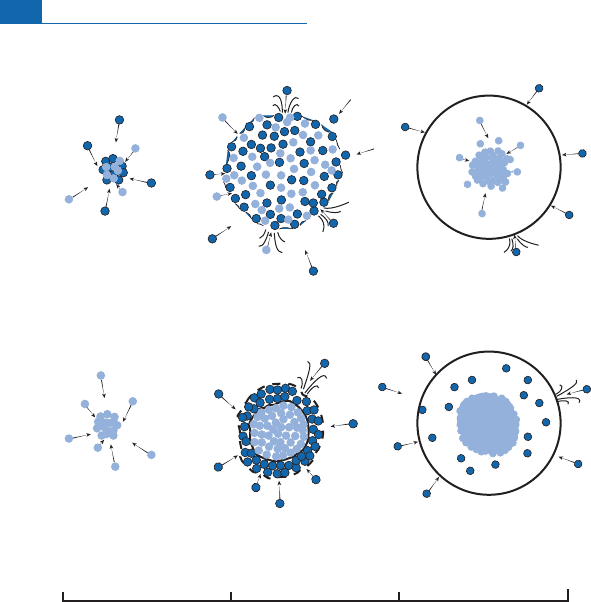All?gre Claude J. Isotope Geology
Подождите немного. Документ загружается.


The oppos ing model by which OIB stems from the core^mantle boundary at a depth of
2900 km is based primarily on seismic tomography. The method yields two essential
results:
(1) In various lo cations corresponding to subduction zones, slabs can be‘‘seen’’ plunging
intothe mantlebeyondthe 670-kmboundary (seeVan de r Hilstet al., 1991;Grandet al.,
1997).
(2) Fine-scale imageryse ems to showsome plumes arise from the core^mantleboundary
whileothers seemto originate at670 km (Montelli etal., 20 04).
This model is not suppor ted by any clear and di rect geochemical arguments. There are
manycounterargumentstotheinterpretations ofthese observations:
(1) If downgoing plateshadplunged intothe lower mantle completely throughout geolog i-
cal time, we would have a global mantle convection regim e. But, as we have seen, the
rare gases require a two-layer mantle. As these slabs are chemically ‘‘depleted struc-
tures’’ becaus e of the extraction of continental crust, it is the lower mantle that would
havean isotopic signature depleted in Srand Nd. Conversely itis the mid-ocean ridges,
whose surface origin is attested by the most reliable part of seismic tomography, that
havesuchasignature.
There are several ways ofovercoming this contradiction b etwe en s eismic tomogra-
phyand isotope geology.
The¢rstis toacceptthatthegeophysicalobservationsrelatetothe presentperiodalone. The
situation must havebeen di¡erent in the past.There must have been a two-layer mantle for
most of geological time, and this layering must have been destroyed only recently. In the
past, onlyas mall fractionofthe slabs mighthaveplunged into thelower mantle.This would
easilyexplainthe isotopic massbalancesof Nd and Sr.
The second is to accept that what the seismic tomography images show is not a down-
going plate but a cold current in the lower m antle convection pattern. A combination of
both interpretations is alsopossible.
Thethirdis to consider thatonlyapart, aboutone-third, ofthe plateis subducted intothe
lower mantle while most of the slabs p ile up in the uppe r mantle as observed by Fukao et al.
(1992).
(2) How, then, can the seismic images of plumes be interpreted? By accepting that the
regimesbetween uppe r and lower mantle are thermallyand not mechanically coupled.
Lower mantle plumes provide heat, whi ch triggers certain instabilities in the 670-km
boundarylayer. And this isprobably the general explanation.The lower mantle^uppe r
mantle coupling is largely the rmal. T his in n o way m eans there are no exchanges of
mas s between the upper mantle and the lower mantle. Such exchanges have been sub-
stantial and about one-third of the lower mantle is reinjected material from the upper
mantle according to th e Sr an d about Nd isotopic mass balance calculation.This pro-
vides a picture, then, of the mantle and of exchanges which have taken place between
thevarious reservoirs throughoutgeologicaltime (Figure6. 7 3).
But we have to distinguish between structure and texture. The stru ctu re consists of
two layers convecting independently but exchanging mass and energy c ontinuously. The
texture is the intimate mixture of pyroxenite strips which are elongated, folded, and
339 Chemical geodynamics

embedded into peridotite i n the upper mantle or ringwoodite (garnet plus spinel) in the
trans ition zone.
Since pyroxenite melts more readily than peridotite, the proportion of pyroxenites con-
tributing tothebasaltic meltis higher than theiractual presence in the mantle.Thispropor-
tion depends on the degree of partial melting and also th e proportion of pyroxenite in the
source. Recent work by Sobolev et al.(20 07) estimates thos e prop ortions in various types
ofbasalt at10% in MORB an d 70% in OIB. Remember that MORB corresponds to10% of
partial m eltingandOIB to 2%.
The MORB source is a well-stirred reservoir whe re pyroxenite has been partially
destroyed.OIBscamefrom asourcewherepyroxenitemakesup10^15%ofthemassbecause
theyareformedwhen subducted slabs pile up.
6.6.9 Comparison and limits of the model
We now have a coherent model of mantle structure and dynamics.While it should not
be taken as an eternal truth, it should not be abandoned either, until we have something
better.
Upper
mantle
Upper mantle
Atmosphere
Continent
Continent
OIBRidge
Ridge
Lower mantle
Lower mantle
OIB
Figure 6.73 Two diagrams of geodynamic mechanisms. Top: using strontium, neodymium, and
hafnium isotopic tracers. Bottom: using rare gases.
340 Radiogenic isotope geochemistry

Direct comparison of geochemical models and geophysical observations
21
is a delicate
business, because, as pointed out, the fundamental processes do not involve th e major ele-
ments much.Yet it is the major elements that, through mineralogy and the physical proper-
ties of minerals, condition geophysics observations. A second reason is that geophysical
observations are made on the Earth as it is today, whereas isotopic g eoche mical observa-
tions cover the 4.5 billionyears of its history. And as we know, the Earth has evolved during
its history.
Onevery importantpointto makeis thatthe re is noguaranteethatthis cyclic process has
been constantthroughoutgeological times, either interms ofspeedor interms ofthe‘‘qual -
ity’’oftheprocess. Assaid, oneofthesources ofthe Earth’s energypower ingmantle convec-
tion is the radioactivity of uranium, potassium, and to a lesser extent thorium. This
radioactivityhas declinedovergeologicaltime.It maybe,then, thatconvectionwas stronger
inthe past, oreventhatits overallstructurewasdi ¡erentfromwhatweknow today.
Theformationofoceanic crustand the extraction ofcontinental crust mayhavebeen dif-
ferent in the past.What suggests this is that we ¢nd in the Archean submarine ultrabasic
lavas (komatiites), which are unknown nowadays and the continental crust contains acid
rocks that are unknown today such as the TTG association (tonalite, trondhjemite,
granodiorite).
Themodelwehavedeveloped,basedontheparadigmofplatetectonics,coversthe4.4bil-
lion years of the Earth’s history, provided the phenomena are qualitatively similar.
However, studies of ancient rocks have notshown any major contradiction.The agreement
obtained between a vision by extrapolation into the past of present-day Sr and Nd isotope
data and the study ofpast variations ofthese isotopes i n shales or komatiites shows theyare
con sistent.We therefore have no hard facts that currently require us to radically change our
mo del, but there is no guarantee this position will not change in the future if newstudies so
require. Meanwhile, let us work with it, without being dogmatic, but without qualms.
Science isneither anunchangeabledogmanoradomainwhere ‘‘anything goes.’’
6.7 The early history of th e Earth
Isotopegeologyhasachievedresultsofconsiderablescope concerningthe Earth’sstructure
and evolution.W hy not apply the s ame methodsofreasoning to extinct forms ofradioactiv-
ity, which would allow us a more precise vision of our planet’s early history? Why deprive
ourselvesofa clos e-up ofthe ¢rstdaysofthe Earth’shistory?
The initial idea is very straightforward, then. Before setting it out in a few examples ^
becausehereasthroughoutthistextbook,thefocusison method ^ itisuseful torecall alittle
vocabulary. It is generally considered thatthe solid material making up the telluric planets
conden s ed from a mostlygaseous primordial nebula toform soli d dust particles.This solid
material then accreted to form eve r larger bodies: grains formed beads, then balls, and
thenbodiesof1km,10 km,100 km in diameter, and so on.Thiswas thep rocessofacc ret ion
during which a fraction ofthe nebula’s gases weretrapped inside the solids. In this context,
therearetwo extreme scenarios fo r explainingtheformation ofthe Earth (Figure 6. 74).
21
Especially the wonderful pictures produced by seismic tomography.
341 The early history of the Earth

Inthehomogeneou saccretion scenario, theaccretedmaterialswereallofthesame com-
p osition.The primordial Earthwas therefore a large sphere ofuniform composition which
then di¡erentiated through a large melting phenomena to make the core, the mantle, and
the atmosphere and perhaps even an embryonic crust as on the Moon.The energy of this
general melting episode came from accretion (tran sformation of potential energy into heat
above all through impacts at the end of accretion), extinct radioactivity and above all
235
U
and
40
K radioactivity, whichweremore‘‘active’’atthetime (see Chapter1).
Theotherscenariois thatof heterogeneousaccretion, whichas sumesthatthe Earth¢rst
accretedits iron core,then subsequently the silicate mantle, and ¢nallythe atmosphere and
o cean.This raises many questions.What was the relative timing of these processes? What
are the mutual relations between them? In an extreme scenario, condensation, accretion,
and di¡erentiation occurred in succession. In more complexscenarios all three operations
are considered as more orless simultaneousorcombined.
We have already answered three essential questions using radiogenic isotopes with long
half-lives.Firstofall,thedi¡erenti ationofthe continentalcrusto ccurredthroughoutgeolo-
gical time but was more active in the past and has an average age of 2^2.3 Ga (this was
derived from Sr^Nd isotope pairs).The core di¡erentiated very early on, with a mean age
of 4.4 Ga (this information was obtained from lead isotopes). The atmosphere outgassed
Core differentiation and
final bombardment
HOMOGENEOUS ACCRETION
HETEROGENEOUS ACCRETION
4.55 4.50 4.454.60
Final
bombardment
Mantle
accretion
Core
accretion
Age (Ga)
Figure 6.74 The two types of accretion.
342 Radiogenic isotope geochemistry

relativelyearlyonwithanaverageageof3.3 Ga(thiswasobtainedfrom
40
Ar).Wearegoingto
testor re¢ne these assertionsusingextinctradioactivities.
6.7.1 The age of the atmosphere and the way it formed
From the
40
Ar balance, it has been established that 50% of the
40
Ar was in the atmosphere
and 50% in the mantle. Fromthis,and from th e
40
Ar/
36
Ar isotope compositions measured
in the atmosphere and mantle, we have calculated a ‘‘model age’’ for the atmosphere of
3.3 Ga. Isthis mo delage reliable?
Letuslook¢rstatthebalanceof
36
Ar, the non-radiogenicisotope.Weknowthatthe man-
tle is made up of two layers convecting separately: the upper one is largely degassed, the
lowerone little d egassed.The
40
Ar/
36
Ar ratios ofthese two reservoirs havebeen measured.
In the upper mantle,
40
Ar/
36
Ar ¼40 000 while the ratio in the lower mantle is 4000. The
ratiointheatmosphereis
40
Ar/
36
Ar ¼296.8.
Exercise
What is the extent of degassing of
36
Ar?
Answer
From the quantities of
40
Ar in the atmosphere and mantle, it can be estimated that the
quantity of
36
Ar in the atmosphere is 2.3 10
17
g and the quantity of
36
Ar in the lower mantle
is 1.7 10
16
g (the quantity of
36
Ar in the upper mantle 5 10
13
g is negligible). Therefore, in
total
36
Ar ¼2.3 10
17
þ1.7 10
16
¼2.47 10
17
g. Therefore the extent of degassing is 93%.
How can we explain the enormous di¡erence highlighted in the pre ceding exercise
between the extent of degassing of
40
Ar (50%) and of
36
Ar (93%)? It is b e cause
40
Ar is
purely radiogenic.Therewas no
40
Ar atthebeginningofth e Earth, only
36
Arand
38
Ar. The
extentofdegassing of
40
Ar m easures ab ove al l outgas sing throughout geological historyby
volcanism and particularly along ocean ridges.The extent of degassi ng of
36
Ar measures
boththatrelated totheprimordial historyandthat relatedtosubsequentgeological history.
The Earth’s history fallsi ntotwo episodes:
Geological historyPrimordial history
IfwecalltheextentofprimordialdegassingP andthe extent ofsubsequent degassing G,the
36
Ar content of the mantle is equal to (1 P) (1 G). We can estimate 1 G ¼0.5 and
1 P ¼0.07 , hence P ¼86%.The extent of primordial degassing of the Earth is enormous
and dominant. Most of the atmosphere formed therefore at the begin ning of the Earth’s his-
tory (Figure 6. 7 5).This is not the impression we gained from the
40
Ar balance! Remember,
though, that
40
Ar was not present initially. It has built up progressively over time. It is
notagoodrecordingsystemforearlytime,butitisagoodrecordingsystemforgeologicaltime.
We are going to re-examine the p roblem addressed with the argon isotopes but this time
using extinct radioactive
129
I, which, as we know, decays to give
129
Xe. Xenon-130 is the
343 The early history of the Earth

stablereferenceisotope. To dothis, wetake abalanceofradiogenic
129
Xe. Supposethe Earth
is degassed to x%.The quantity of
130
Xe in the atmosphere is
130
Xe
total
x.The quantityof
129
Xe* (
129
Xe* is the excess of
129
Xe relativeto theusualabundance in meteoritesrelativeto
other isotopes) of the atmosphere is estimate d at 3.63 10
13
g. If x% degassing is high, the
quantity of
129
Xe* in the atmosphere is equal to that of
129
I at the time the Earth began to
retain its atmosphere quantitatively, thatis, thetimethe Earthwasbigenough for xenon not
to escape.
For primordial gas, we take a rate analogous to that of
36
Ar of 9 0%. If
130
Xe
atmosphere
¼8 10
13
g and the extent of degassing is 90%, we therefore have a balance:
130
Xe
total
¼8.8 10
13
g.
Therefore
129
Xe/
130
Xe ¼(
129
I/
130
Xe)
accretion
¼0.4125.
But
129
Xe/
130
Xe ¼(
129
I/
127
I) (
127
I/
130
Xe) .
This expression is intended to bri ng out the isotope ratio of iodin e which does not frac-
tionate atthe time of accretion but varies with the radioactive decayof
129
I. Iodine-127 may
be estimated at 25 ppb of iodine in 4 10
27
g, which is the mass of the mantle, making
1 10
20
g in all.Wethereforeobtain
127
I/
130
Xe ¼1.13 10
6
,hence
129
I=
127
I ¼ 0:36 10
6
:
We canthen calculatea modelagerelativetoameteoritewhose initialiodineisotoperatio
has been determined. The carbonaceous meteorite taken as the reference has a
(
129
I/
127
I)
initial
ratio ¼1.1 10
4
.
4321 0
2
3
1
0
40
Ar flux (10
10
g yr
–1
)
10 20
1
30
2
3
4
Ma
4 3 2 10
10
6
10
8
10
10
0
36
Ar flux (g yr
–1
)
g a
1
10 20
10
7
30
10
8
10
9
10
10
Ma
2
4
3 2 1
1
0
129
Xe* flux (10
5
g yr
–1
)
Age (Ga)
20 40
1
2
Ma
Radiogenic gas
0
Figure 6.75 Scenario of primordial degassing of the Earth’s atmosphere. After Sarda
et
al
.(1985).
344 Radiogenic isotope geochemistry

DT ¼
1
l
ln
129
I
127
I
initial
129
I
127
I
Earth
6
6
6
6
6
6
4
7
7
7
7
7
7
5
;
therefore T=148 Ma.Th e Earththe refore retained itsatmosphere150 Maafter theform a-
tionofthe carbonaceous chondrites, or as an absolutevalue,
T
acc
¼ T
ch
0:148 ¼ 4:565 0:148 ¼ 4:41 Ga;
an average age, which, it should be noted, corresponds almost to the mean age of the core
determinedusing lead isotopes.
Wehavejustseenthenthat mostoftheatmospherewasdegassedveryearlyon, but10%or
so comes from subsequent degassing, probably from the upper mantle and in conjunction
with the plate tectonics cycle.We accordingly have a picture of the primordial Earth with a
veryhigh extentofdegassing, intensebombardmentbylarge objects, volcanism, and di ¡er-
entiation ofthe core.
6.7.2 The age of the Earth’s core and the mode of terrestrial
accretion
Wehave alreadydetermined an age for the Earth’s corewith lead isotopes using thefactthat
lead has a great a⁄nity for lead sul¢de (PbS). We can test this result using extinct
182
Hf^
182
Wradioactivity, for wh ichT
1/2
¼9 Ma.This isotope pair has a peculiar chemical
prope rty which is that tungsten is a si derophile element: it enters metallic iron when ever it
can, whereas hafnium is l ithophile.The i ron^silicate division therefore corresponds to a
very imp ortant W^Hf chemical fractionation. This is how it has been possible to date
meteoritesand studythe evolutionofthis form ofradioactivity in thesolar nebula.
Weshallexaminethis aspect¢rstbefore concerningourselveswiththe ageofthe Earth.It
is possible, as we saw when studying chronological methods, to make precise datings of
eventswhichtook placewhen
182
Hfradioactivity wasnotyet‘‘dead.’’
To study these events, we have isochron diagrams of anc ient objects (
182
Hf/
184
W,
182
W/
184
W) (see Chapter 4). The slope of the isochron gives the
182
Hf/
184
W ratio. This
182
Hf/
180
Hf isotope ratio does notfractionate during the chemical fractionation processes.
It deca ys by the law
182
Hf=
180
Hf ¼ð
182
Hf=
180
HfÞ
0
e
l
Hf
t
;
which allows us to determine a relative age as soon as a reference has been ¢xed for the
(
182
Hf/
180
Hf)
initial
ratio. In thisway time canbe measured in absoluteterms.
We also have the (
182
W/
184
W
initial
) ratios of isochrons constru cted for meteorites
(Figure6.76).Thisratioincreasesasageincreases(thereforeas
182
Hfdecreases).
If it is supposed that meteorites derive from the condensation of the primordial solar
nebula and supp osing thatthis nebulaevolves in a closed system, the (
182
W/
184
W)
initial
ratio
varieswiththe equation:
345 The early history of the Earth

182
W
184
W
initial
tðÞ ¼
182
W
184
W
present
180
Hf
184
W
182
Hf
180
Hf
:
If we draw a g raph, positing Y ¼
182
W=
184
W
and x ¼ e
lt
¼
182
Hf=
180
Hf,theevolu-
tion of the primordial nebula is therefore a straight line whose (negative) slope
is ^(
180
Hf/
184
W), and therefore proportional to the Hf/Wchemical ratio.When we plot on
the graph the values extracted from the chondrite isochrons and the current
182
W/
184
W
ratio of carbonaceous chondrites C
I
, we do indeed de¢ne a straight line whose slope corre-
sponds to the chemical Hf/W ratio of C
I
:
180
Hf/
184
W ¼1.55, which value corresponds to
Hf/W ¼1.31.
This graph is the equivalent of the (
87
Sr/
86
Sr, t) isotope evolution diagram, except that
timeisgraduated exponentiallyby the
182
Hf/
180
Hfratio.
It is interesting to situate two types of di¡erentiated meteorite on this diagram: iron
meteorites and basaltic achondrites. For iron meteorites, the straight line of evolution in
the isotope evolution diagram is horizontal since Hf ¼0. Now , the
182
W/
184
W ratios are
very low, among the lowest measured for meteorites. These ratios correspond to very
an cient, primordial ratios.This shows that iron di¡erentiated veryearlyon inthe small par-
ent bodies known as plan ete si mal s. Basaltic achondrites have very high
182
W/
184
W ratios
and their initial ratios lie far above the straight line of evolution of the nebula. The H f/W
ratio of silicates of the parent body, which c an be estimated, set the di¡erentiation at 3 to
8 Ma after that of the iron meteorites, but at the same time as di¡erentiation of meteorites
compos edofthe iron^metal mixture.
Andthe Earth? TheEarth hasa
182
W/
184
W valuethatstandsapartfromthatofthe carbo-
naceous chondrites. This shows that Hf/W di¡erentiation, that is, segregation of the core
from the mantle, occurre d when
182
Hf was not yet extinct (Figure 6. 77). But what, then, is
the model age ofthis di¡erentiation?
Exercise
We are given
182
W=
184
W
Earth
present
¼ 0:8650. The
182
W=
184
W
carbonaceous
chondrites
present
ratio is equal to that of
the nebula, 0.864 83. The Hf/W ratio of the nebula is 1.31 and the Hf/W ratio of the Earth’s
mantle is 20. We suppose that:
182
Hf/
184
W
ε
W
182
Hf/
180
Hf
=(1.0
±
0.5)
x
10
–4
(σ)
NM-3
NM-2
M
Forest Vale
NM-1
4
2
4 6
2
0
-2
NM-3
M
St.Marguérite
NM-1
ε
W
182
Hf/
180
Hf
=
(0.85
±
0.05)
x
10
–4
(2σ)
2 6 10 14
0
8
4
NM-2
Figure 6.76 Graphs of
186
Hf–
186
W isochrons of two chondrites. After Kleine
et
al
. (2004).
346 Radiogenic isotope geochemistry

180
Hf
184
W
¼
Hf
W
chemical
0:845:
Calculate the model age of core–mantle differentiation estimated by
182
Hf–
182
W chronology.
Answer
We wish to calculate the initial (
182
Hf/
180
Hf)
initial
ratio of the Earth’s mantle. The time at
which it acquired its current chemical ratio is written
T
diff
. The equation for evolution of the
solar nebula is:
182
W
184
W
present
¼
182
W
184
W
T
diff
180
Hf
184
W
nebula
182
Hf
180
Hf
initial
:
Likewise:
182
W
184
W
Earth
¼
182
W
184
W
T
diff
180
Hf
184
W
mantle
182
Hf
180
Hf
:
The solution to this system of two equations with one unknown gives:
ð
182
Hf=
180
HfÞ
initial
¼ 1:1 10
5
:
0.8650
0.8649
0.8648
0.8647
0.8646
10 20 30
182
Hf/
180
Hf×10
4
182
W/
184
W
Bulk Earth
CC
TLA
Iron
meteorites
M
Basaltic
achondrites
FV
Ordinary
chondrites
Solar
nebula
Figure 6.77 Isotope evolution diagram for W–Hf. M, St. Marguerite; CC, carbonaceous chondrites; TLA,
Tlacotepec (an iron meteorite); FV, Forest Vale; carbonaceous chondrites.
347 The early history of the Earth

If we consider the initial reference ratio for the Solar System is
182
Hf/
180
Hf ¼2.4 10
4
, then:
DT ¼
1
l
ln
2:4 10
4
1:1 10
5
and 1/
l
¼13 Ma. Hence
T
¼40 Ma after the formation of the chondrites.
The Hf^W age of 40 Ma calculated in the previous exercise is very di¡erent from the
150 Ma estimated from Pb isotopes. How can we overcome this contradiction? By coming
backto meteorites and remembering that in their small parent bodies, iron became di¡er-
entiated very early on.The bodies that accreted to form the Earth were the refore probably
already di ¡erentiated bodies where the iron was already separated from the silicates. The
age of 40 Ma is a mixed age between these primordial ‘‘meteorite’’ ages and the average
age of di¡erentiation of the core indicated by lead isotopes. It is therefore an indication
that accretion of th e Earth involved solid bodies that were already di¡erentiated. This is
an i nter me diate sc enar io between homogeneous and heterogeneous accretion.Itis
homogeneous accretion of a heterogeneous p roduct! The core di¡erentiated 150 Ma
after primitive condensation but its di¡erentiation occurred on solid bodies in which sili-
cate^iron had already di¡erentiated.The Hf^W 40 Ma age is a mixture between the two
events.
Exercise
The isotope ratios of the Earth and carbonaceous chondrites are known with a precision of 15
ppm. The initial ratio is known with precision of 20%. Uncertainties on Hf/W ratios are
assumed negligible. What are the uncertainties on the estimation of
T
of Earth–core
differentiation calculated by Hf–W?
Answer
D
T
¼ 40
þ44
35
Ma, or 10 Ma, which does not alter the reasoning.
6.7.3 The primitive crust and
146
Sm–
142
Nd
Samar ium-14 6 de cays to
142
Nd by decay w ith a decay constant l ¼6.849 10
9
(nearly a
thousandtimeslessthan
147
Sm!).Itisanexti nctradioactivity.Wehaveseenthatthecontinen-
tal cru st has a lower Sm/Nd ratio than the mantle. Accordingly
143
Nd/
144
Nd ratios of
MORB are positive when expressed in "
Nd
, whereas values for the c ontinental cru st are
n egative.The i death en was to try to determine whether a pr imitive crust had separated out
during the early di¡erentiation of the Earth and if such segregation had left traces in the
142
Nd/
144
Nd ratiosuchas arefoundfor the
129
Xe/
130
Xe ratio .
This ideawas put forward by Stein Jacobsen of Harvard University. He and his student
Chris Harper (Harperand Jacobsen,1992)claimedtohavefoundapositive
142
Ndanomaly
inveryancient rocksofGreenland.Thiswasnot
Nd
measured in10
4
butdi¡erences inppm
10
6
(100 ")
1
.They reported enrichm ents of 30 pp m of
142
Nd comparedwithun iform and
identical valu es of MORB, OIB, and recent and ancient rocks. The measurements were
348 Radiogenic isotope geochemistry
